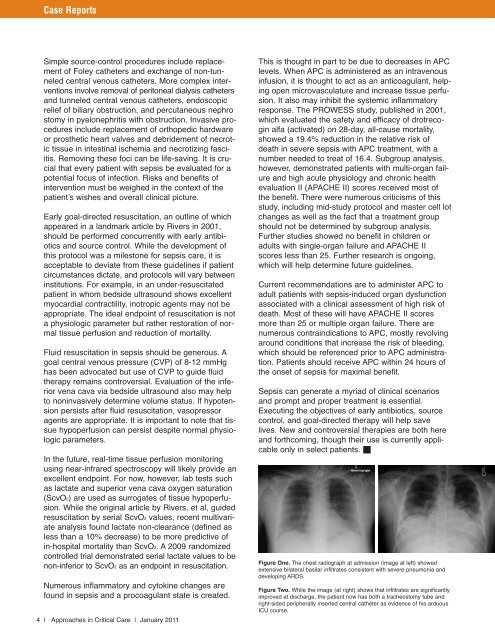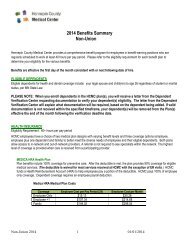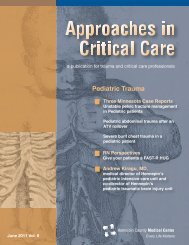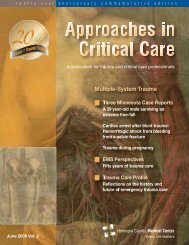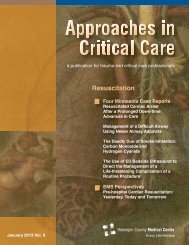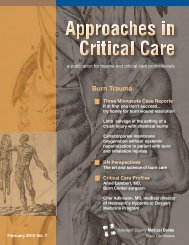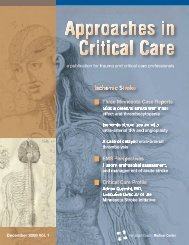Sepsis - Hennepin County Medical Center
Sepsis - Hennepin County Medical Center
Sepsis - Hennepin County Medical Center
Create successful ePaper yourself
Turn your PDF publications into a flip-book with our unique Google optimized e-Paper software.
Case Reports<br />
Simple source-control procedures include replacement<br />
of Foley catheters and exchange of non-tunneled<br />
central venous catheters. More complex interventions<br />
involve removal of peritoneal dialysis catheters<br />
and tunneled central venous catheters, endoscopic<br />
relief of biliary obstruction, and percutaneous nephro<br />
stomy in pyelonephritis with obstruction. Invasive procedures<br />
include replacement of orthopedic hardware<br />
or prosthetic heart valves and debridement of necrotic<br />
tissue in intestinal ischemia and necrotizing fasciitis.<br />
Removing these foci can be life-saving. It is crucial<br />
that every patient with sepsis be evaluated for a<br />
potential focus of infection. Risks and benefits of<br />
intervention must be weighed in the context of the<br />
patientʼs wishes and overall clinical picture.<br />
Early goal-directed resuscitation, an outline of which<br />
appeared in a landmark article by Rivers in 2001,<br />
should be performed concurrently with early antibiotics<br />
and source control. While the development of<br />
this protocol was a milestone for sepsis care, it is<br />
acceptable to deviate from these guidelines if patient<br />
circumstances dictate, and protocols will vary between<br />
institutions. For example, in an under-resuscitated<br />
patient in whom bedside ultrasound shows excellent<br />
myocardial contractility, inotropic agents may not be<br />
appropriate. The ideal endpoint of resuscitation is not<br />
a physiologic parameter but rather restoration of normal<br />
tissue perfusion and reduction of mortality.<br />
Fluid resuscitation in sepsis should be generous. A<br />
goal central venous pressure (CVP) of 8-12 mmHg<br />
has been advocated but use of CVP to guide fluid<br />
therapy remains controversial. Evaluation of the inferior<br />
vena cava via bedside ultrasound also may help<br />
to noninvasively determine volume status. If hypotension<br />
persists after fluid resuscitation, vasopressor<br />
agents are appropriate. It is important to note that tissue<br />
hypoperfusion can persist despite normal physiologic<br />
parameters.<br />
In the future, real-time tissue perfusion monitoring<br />
using near-infrared spectroscopy will likely provide an<br />
excellent endpoint. For now, however, lab tests such<br />
as lactate and superior vena cava oxygen saturation<br />
(ScvO2) are used as surrogates of tissue hypoperfusion.<br />
While the original article by Rivers, et al, guided<br />
resuscitation by serial ScvO2 values, recent multivariate<br />
analysis found lactate non-clearance (defined as<br />
less than a 10% decrease) to be more predictive of<br />
in-hospital mortality than ScvO2. A 2009 randomized<br />
controlled trial demonstrated serial lactate values to be<br />
non-inferior to ScvO2 as an endpoint in resuscitation.<br />
Numerous inflammatory and cytokine changes are<br />
found in sepsis and a procoagulant state is created.<br />
4 | Approaches in Critical Care | January 2011<br />
This is thought in part to be due to decreases in APC<br />
levels. When APC is administered as an intravenous<br />
infusion, it is thought to act as an anticoagulant, helping<br />
open microvasculature and increase tissue perfusion.<br />
It also may inhibit the systemic inflammatory<br />
response. The PROWESS study, published in 2001,<br />
which evaluated the safety and efficacy of drotrecogin<br />
alfa (activated) on 28-day, all-cause mortality,<br />
showed a 19.4% reduction in the relative risk of<br />
death in severe sepsis with APC treatment, with a<br />
number needed to treat of 16.4. Subgroup analysis,<br />
however, demonstrated patients with multi-organ failure<br />
and high acute physiology and chronic health<br />
evaluation II (APACHE II) scores received most of<br />
the benefit. There were numerous criticisms of this<br />
study, including mid-study protocol and master cell lot<br />
changes as well as the fact that a treatment group<br />
should not be determined by subgroup analysis.<br />
Further studies showed no benefit in children or<br />
adults with single-organ failure and APACHE II<br />
scores less than 25. Further research is ongoing,<br />
which will help determine future guidelines.<br />
Current recommendations are to administer APC to<br />
adult patients with sepsis-induced organ dysfunction<br />
associated with a clinical assessment of high risk of<br />
death. Most of these will have APACHE II scores<br />
more than 25 or multiple organ failure. There are<br />
numerous contraindications to APC, mostly revolving<br />
around conditions that increase the risk of bleeding,<br />
which should be referenced prior to APC administration.<br />
Patients should receive APC within 24 hours of<br />
the onset of sepsis for maximal benefit.<br />
<strong>Sepsis</strong> can generate a myriad of clinical scenarios<br />
and prompt and proper treatment is essential.<br />
Executing the objectives of early antibiotics, source<br />
control, and goal-directed therapy will help save<br />
lives. New and controversial therapies are both here<br />
and forthcoming, though their use is currently applicable<br />
only in select patients. ■<br />
Figure One. The chest radiograph at admission (image at left) showed<br />
extensive bilateral basilar infiltrates consistent with severe pneumonia and<br />
developing ARDS.<br />
Figure Two. While the image (at right) shows that infiltrates are significantly<br />
improved at discharge, the patient now has both a tracheostomy tube and<br />
right-sided peripherally inserted central catheter as evidence of his arduous<br />
ICU course.


